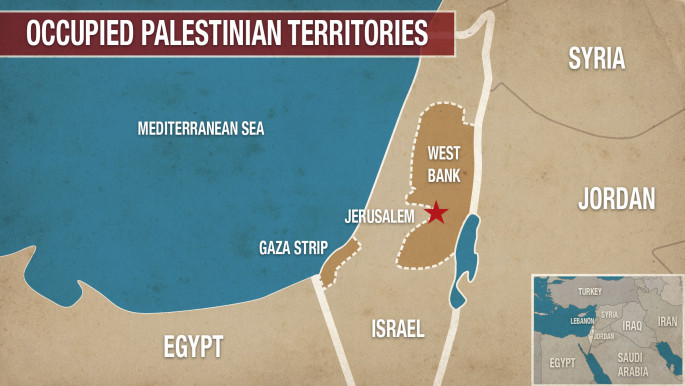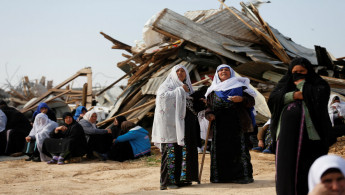Why is Israel demolishing Bedouin homes in Umm al-Hiran?
A Palestinian citizen of Israel and an Israeli police officer were killed on Wednesday after dozens of police were deployed to oversee a house demolition in a Bedouin village in southern Israel.
Yacoub Abu al-Qi’an was shot and killed during what Palestinian legal rights group Adalah described as a “violent incursion” by Israeli police into the Bedouin village of Atir-Umm al-Hiran.
Atir-Umm al-Hiran is a village of about 1,000 residents – all Palestinian citizens of Israel – in the country’s southern Negev desert region.
Israeli police said Abu al-Qi’an, a 50-year-old local teacher, purposely drove his car into a group of police officers in the village, killing one.
Israeli President Reuven Rivlin described the incident as an “abhorrent terrorist attack,” and police said he was shot after he carried out the so-called “ramming attack”.
But eyewitnesses in the village at the time have disputed this Israeli version of events.
“Eyewitnesses have confirmed that Abu Al-Qi'an was trying to leave the village and lost control of his car only after police fired at him,” Adalah, the legal centre for Palestinian citizens of Israel, said in a statement.
An activist from the village, Raed Abu al-Qi’an, also said, "the Israeli narrative is a lie”.
“He was a revered school teacher. He has no relations with the Islamic Movement," he told Agence France Presse news agency. "He was in his car and they shot at him from everywhere."
Several residents from the village, local activists, and a Palestinian lawmaker, Ayman Odeh, who heads the Joint List, the third largest party in the Israeli parliament, were injured in the violence.
 |
|
| [Click to enlarge] |
Why were Israeli police in Atir-Umm al-Hiran in the first place?
Israel argues that the residents of Atir-Umm al-Hiran have built their homes without legal permits, and the police were deployed to supervise the demolition of a home in Atir-Umm al-Hiran.
In the eyes of the state, the village is “unrecognised,” which means that all structures built in the village are subject to demolition.
What does it mean for a Bedouin village to be “unrecognised” in the Negev?
Ranging from a few hundred to thousands of residents, unrecognised Bedouin villages are considered to be illegal settlements by the Israeli government.
As a result of this legal status, they are denied basic services from the state, including paved roads, water and sanitation systems, electricity, health facilities, and schools, and housing permits are impossible to come by.
About 40 Bedouin villages are currently deemed “unrecognised” in the Negev region.
In the case of Atir-Umm al-Hiran, the residents – members of the Abu al-Qian Bedouin tribe – were forcibly displaced from their ancestral lands in Khirbet Zubaleh in 1948 following the creation of the state of Israel.
Most of the Bedouin tribes that remained in the new state at that time were contained under military rule in an area known as the Siyag, in the northern Negev, which was known for the low yield of its agricultural lands.
After being forcibly relocated several times by the Israeli authorities, an Israeli military governor re-settled the Abu al-Qian tribe in 1956 on lands in Wadi Atir, in the district of Be’er Sheva.
Despite being forcibly relocated by an Israeli military order, and having lived in this same location for over six decades, the village of Atir-Umm al-Hiran was never formally recognised.
Why does Israel want to move them again?
Israel wants the residents of Atir-Umm al-Hiran to move into the nearby Bedouin township of Hura to make way for a new, Jewish-only town to be named Hiran. Israel also plans to plant a forest over another section of the village’s current lands.
Residents have resisted the state’s efforts to displace them for years, even taking their fight to Israel’s High Court.
The Israeli Land Administration, which controls land allocation for the state, described the village in 2001 as a “special obstacle” to establishing new Jewish settlements in the Negev, according to a report by Adalah, the legal centre for Palestinian citizens in Israel.
 |
Israel has pursued a policy of forced Bedouin urbanisation since the late 1960s |  |
The residents of Atir-Umm al-Hiran have asked to be allowed to stay in their current location and live side-by-side with the new Jewish settlement of Hiran. But that request was refused on the basis that the Bedouin would not fit into the social fabric of the new community.
Finally, in January 2016, the High Court rejected the residents’ final appeal. It ruled the destruction of Atir-Umm al-Hiran could move ahead as planned, despite the residents’ claim that removing them from their land will destroy their traditional way of life.
“The Israeli Supreme Court's decision to allow the state to proceed with its plan to demolish the village … is one of the most racist judgments that the Court has ever issued,” Adalah said in a statement on Wednesday.
“The Israeli government and its leaders then took advantage of this court decision to continue its home demolition policy against Arab communities.”
Why does Israel want Bedouin to live in urban settlements in the Negev?
Israel has pursued a policy of forced Bedouin urbanisation since the late 1960s.
More than 100,000 Bedouin citizens currently live in seven Bedouin townships, but these communities are rife with poverty and crime, lack basic services, and lack the space to expand to meet the local population’s housing needs.
According to human rights groups and local activists, the state’s policy aims to concentrate Bedouin citizens on as little land as possible, while maximizing land use and resources for the benefit of the state’s Jewish citizens.
In contrast to the living options offered to the Bedouin, Jewish citizens in the Negev can choose between living in a moshav (agricultural settlement), kibbutz (communal living settlement), city, town, or an individual farm.
 |
It is important to note that house demolitions are carried out in all Bedouin communities, regardless of their legal status |  |
Individual farms provide a single family with hundreds of acres of land for agricultural use, and they are immediately hooked up to basic services like electricity and water.
“Transferring the residents to a town characterized by over population, lack of basic services and extremely high percentages of unemployment and poverty, is not a significant compensation,” Amnesty International has reported, about the forcible transfer of Atir-Umm al-Hiran residents to Hura.
“In addition, this plan ignores the Bedouins’ political, social and historical attachment to their land.”
How prevalent are home demolitions in the Negev?
In 2015, 982 housing structures were demolished in the Bedouin community in the Negev, according to local advocacy group, the Negev Co-Existence Forum (NCF).
Of this figure, 63 percent of the demolitions were carried out by the structures’ owners to avoid the costs associated with a demolition carried out by state actors, NCF found in its annual report on Bedouin home demolitions.
It is important to note that house demolitions are carried out in all Bedouin communities, regardless of their legal status, NCF explained, including government-planned towns, newly-recognised villages and unrecognised villages.
“The scarcity of land for development plots, the lack of official planning even in recognised villages, and the impossibility of obtaining construction permits, brings about a situation where many houses and buildings are being built ‘illegally’ since no legitimate solutions are available,” the group reported.
Demolitions take place regularly across the Negev, and many involve the use of force by Israeli security forces.
On Wednesday, the Arab Association for Human Rights said that the “demolitions and the use of violence” in Atir-Umm al-Hiran signifies “that the Israeli government and police still regard Arabs to be ‘enemies of the state’”.Jillian Kestler D'Amours is a journalist based in Canada. Follow her on Twitter: @jkdamours



